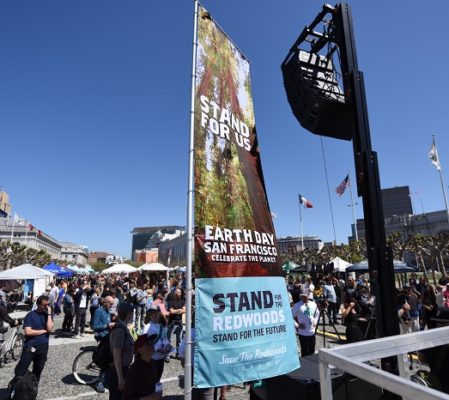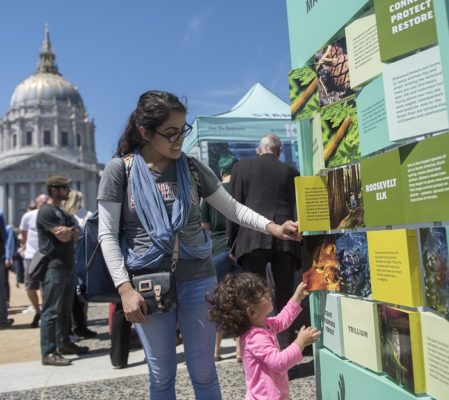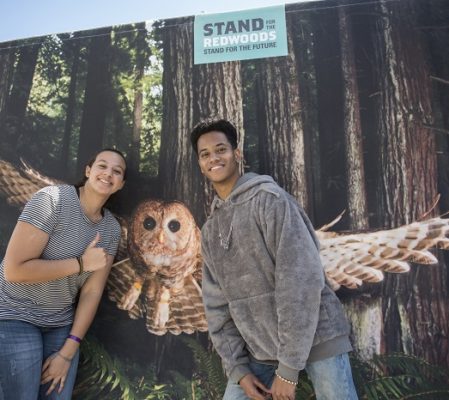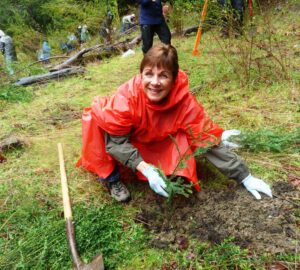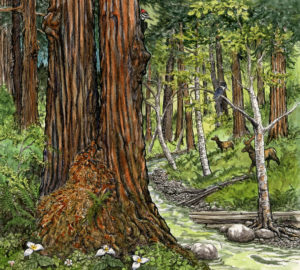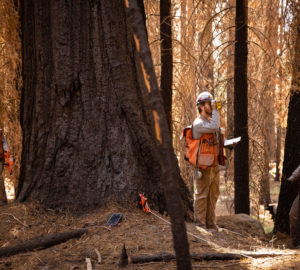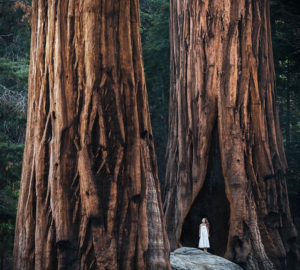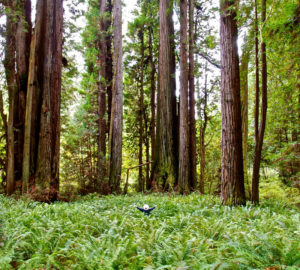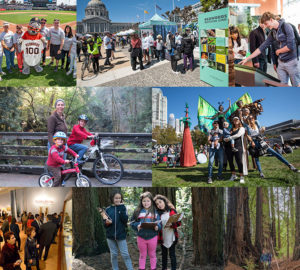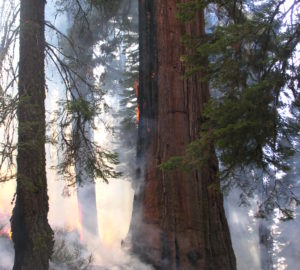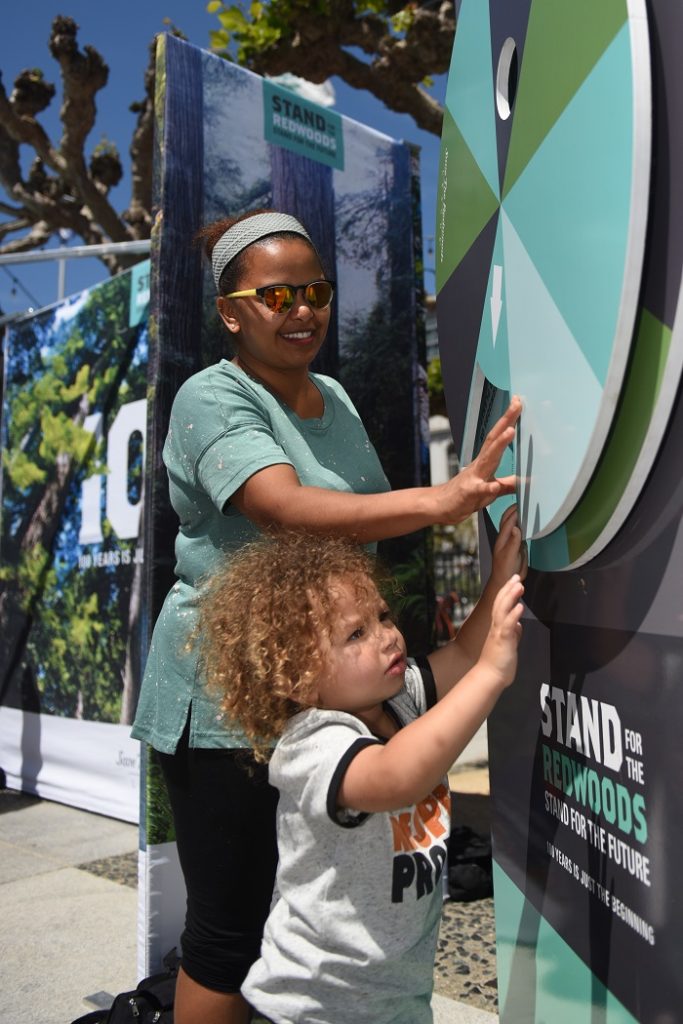
“The more I learn, the more I’m flabbergasted,” said Daniel H., one of the thousands of people at the Annual Earth Day Festival sponsored by Save the Redwoods League. Daniel, who stopped by the League’s new booth, was reacting to learning about League research that showed redwood forests store more carbon per acre than any other forest in the world. The findings confirmed that redwoods are a critical resource in our response to climate change. “We have to save redwoods to protect ourselves,” Daniel said.
At the April 21 festival themed “Stand for the Redwoods, Stand for The Future,” our festival booth was a centerpiece in San Francisco’s Civic Center Plaza.
Daniel’s reaction was like those of hundreds of attendees who experienced moments of joy, wonder and appreciation at the League’s booth, where they learned about the world’s tallest, largest and some of the oldest trees.
Lawrence Greywolf admired the booth’s mural-like photos of amazing redwood and giant sequoia forests. “Redwoods help us find balance,” he said. “The energy is different. It changes our reality and how we approach things.”
Kelly Benson agreed. “The forest is calming,” she said. “The ancientness of it is special. You talk softer, walk slower.”
Selam Jaser and her young son Zachary learned about the forest in our new Redwoods Matching Game, in which players match the names of forest plants and animals with their photos. “We raised our kids to love the outdoors,” Selam said. “We love Muir Woods and hiking. Zachary loves anything green.”
Meanwhile, in our Redwoods Canopy Speakers’ Tent, festival-goers enjoyed interactive talks with the League’s staff about the secrets of the redwood forest and more.
Here are highlights from our panel:
Redwoods’ Secret Superpowers
- QUESTION:
Redwoods and giant sequoia are known for being the tallest and largest trees on the planet, which is incredible, but what are some of the secret superpowers these trees have that make them so successful and able to live for millennia?- ANSWER:
Andrew Slack, Forest Fellow: Redwoods are the most resilient tree I’ve ever studied. They’re pretty remarkable. They have a lot of tannins in their wood that are toxic, so there are very few pests and pathogens that attack them. They’re also one of the most fire-adapted trees that we have in the West. They have thick bark and high canopies and are really good at being able to resist the negative effects of fire.Emily Burns, Director of Science, Planning & Education: One of the interesting things about coast redwoods is they live here along the coast of California in the fog belt. They are amazing because their leaves absorb fog. When the fog comes in, it moves horizontally from the ocean onto land. These tiny water droplets make contact with the leaves and the stems atop these trees. Even if the leaves absorb just a tiny bit of water, it helps those trees get really hydrated. So during the summer, when we typically don’t get rain here in California, we get this pulse of water coming into the canopy of the coast redwood forest, which is a boost that allows this growing season to be even longer.
- ANSWER:
- QUESTION:
League research has shown redwoods contain an amazing variety of plants and wildlife in their canopies. What have you discovered?- ANSWER:
Emily Burns, Director of Science, Planning & Education: Well one of the things I love about the coast redwood forest is that its most common animal is salamanders. If you add up all the salamanders in a forest, it’s way more than any of the other species added together. There are salamanders that live on the forest floor. There are big, giant salamanders that bark, which is awesome. The Pacific giant salamander is one of the common ones that can get really big, like a foot long.And then there’s the wandering salamander that lives up in the canopy. It’s a lungless salamander. It just breathes oxygen in through its skin, so it’s really sensitive to moisture. It can live its whole life up at the top of a single, old redwood tree. We’re finding that, when it is dry and warm, they burrow into fern mats that are growing at the top of redwood branches, and they wait until it’s moist. When the fog rolls in, they come out to hunt. They eat any kind of insect they can find up there.
- ANSWER:
- QUESTION:
What are your other discoveries about redwoods?- ANSWER:
Andrew Slack, Forest Fellow: Redwoods have a really interesting fire history. A lot of recent research has shown that some of these forests across the entire range can burn as often as once every decade or two. The trees were able to survive it, and this is where the redwoods’ adaptions to fire really come into play. That thick bark and that high canopy allow them to withstand that fire. It really helps them become the dominant species in a healthy forest ecosystem.It’s only recently become more widely believed that Native American tribes were the main source of fire for 10,000 years. I like to think that humans and fire and redwoods have really formed this symbiotic relationship. Redwoods actually have incredibly flammable litter, and that actually encourages the spread of fire. So humans start the fire, redwoods will spread the fire, and then both actually benefit from the result of fire. Native American tribes found a lot of species do a lot better after fire, like hazel and willow, which are resources they use for basketry. Frequent fires decrease the fuel loading (accumulation of combustible vegetation) so that reduces the risk of a high-intensity fire that redwoods may not be able to survive. Also, fires frees up growing space.
Sam Hodder, President and CEO: Redwood forests sequester more carbon above ground than any other ecosystem. They have more leaf surface area, which means they do more photosynthesis, which means they produce more wood, which means they pull in more carbon out of the air. Here, in California, in our backyards, we are stewarding and responsible for one of the greatest resources in the fight against climate change.
- ANSWER:
- QUESTION:
What can anyone do to help protect the redwood forest?- ANSWER:
Sam Hodder, President and CEO: First and foremost, on June 5, Californians can vote “yes” on Proposition 68, The Clean Water and Safe Parks Act, a bond measure to support parks, natural resource protection, climate adaptation, water quality and supply, and flood protection. This is millions of dollars that are going into the resources that we care about most.Also, visit a redwood park, and as you explore the redwood forest, remember that you are walking through a California resource that is a critical tool in the fight against climate change. And then when you come back, visit SaveTheRedwoods.org and learn what you can do to support our work.
Our new State of Redwoods Conservation Report details how coast redwoods and giant sequoia are facing some of their most significant, cumulative challenges yet. Their conservation status warrants caution and requires action. Save the Redwoods League has a Centennial Vision to safeguard these ancient groves and heal the redwood forests that surround and sustain them.
This is an extraordinary opportunity to set in motion the regeneration of the ancient redwood range that will inspire future generations.
- ANSWER:
Come and celebrate our Centennial at our many events this year. We look forward to seeing you there.
